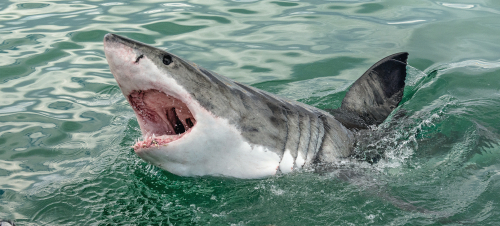
Shark Attacks: The Facts
What’s your worst nightmare? For many of us, that might well be our preconceived notion of a shark attack. However, chomping through the hype, just what is the reality surrounding the reports of shark attacks?

Image: Csilla Peter/Shutterstock.com
Review of the 2019 Stats on Shark Attacks
In 2019, according to the International Shark Attack File (ISAF), there was a total of 64 confirmed unprovoked and 41 provoked shark attacks made on humans, with 12 made on boats, globally. The unprovoked total was notably lower than the most recent five-year average (2014-2018) of 82 incidents per annum. And, while there were 5 recorded fatal shark attacks globally for 2019, only two of these were documented as being unprovoked attacks. Thus, the recorded deaths due to shark attacks in 2019 are completely consistent with the long-term annual average of 4 fatalities per year.
However, despite the best efforts of ISAF, the actual number of worldwide shark attack incidents and subsequent fatalities to some degree remains uncertain. This is due to the fact that the majority of developing coastal nations do not have reliable if any, methods in place for the reporting of shark interactions with humans. Thus, such incidents and fatalities, both near-shore or at sea, will often remain unsolved and/or unpublished.
Provoked or Unprovoked?
Provoked attacks are considered to be those that occur when a human has touched, be it intentionally or accidentally, or otherwise aggravated a shark in any way. While hooking or netting a shark, would be an obvious provoked attack, so would an innocuously grazing with a surfboard. Additionally, incidents that occur outside the shark’s natural habitat, such as at aquariums, research holding-pens, or other dealings involving captured sharks, are also considered to be provoked attacks.

A Sharks eye view Image: Joost van Uffelen/Shutterstock.com
Unprovoked attacks are considered to be those that have been initiated by the shark in its own natural habitat, where there is no human provocation whatsoever.
Shark Attacks or Encounters?
Encounters with sharks are often termed as a “shark attack” by the masses. However, marine biologists and others involved in aquatic conservation, almost unanimously agree that the use of the term is based largely on the misconception that large predatory sharks deliberately seek out humans as prey. The expert school of thought is that it is a very rare occasion where a shark carries out a clear premeditated “attack” on a human and that the incident should merit the use of the term ‘’shark attack’’.
It is suggested that it would be much more accurate to class most shark incidents as being either; “a sighting”, “an encounter”, ” a bite incident”, or “a fatal bite incident”. In these instances, ‘sightings’ would not include any physical interaction, ‘encounters’ would include physical interaction without harm, shark ‘bites’ would be classified as being either minor or major, and ‘fatal bite incidents’’ would obviously be those that result in death. The pundits also recommend that the term ‘‘shark attack’’ should only be used to describe any such incident when an expert has validated the predatory intention of the shark.

Image: Andrea Izzotti/Shutterstock.com
Friend or Foe?
There are more than 500 recognised species of shark throughout the world. They range from the colossal but docile whale shark, which has been recorded at lengths of up to 60 ft (18 m), to the pocket-sized Dwarf Lantern Shark, which will be lucky to measure in at 6” (150 mm).

Image: Sergey Uryadnikov/ Shutterstock.com
Yet, despite the relative number of species of shark, there is only a handful of these that are recognised by the experts as being dangerous to humankind. The Great White Shark, Tiger Shark, and Bull Shark are ‘the big three’ when it comes to incidents of shark attacks and subsequent fatalities. However, this may be attributed to the fact that these are large predators, more capable of inflicting serious injury on a victim than many other species. Additionally, they are commonly found in sea areas frequented by swimmers. In theory, almost any shark species around 6 ft (2 m) in length is a potential threat to humans, since even just an exploratory bite could lead to serious injury.
The Oceanic Whitetip
While recent statistics still identify the ‘big three’ as the most prolific attackers, there are other species that are known to make unprovoked attacks on humans. For instance, the oceanic whitetip is known to be a shark that will make unprovoked attacks. It is thought that because its attacks are far more likely to be out in the open ocean, incidents involving the whitetip are far more likely to go unreported than in other cases.
Notorious events involving attacks by the whitetip shark include the sinking of the Nova Scotia. The British ocean liner, which had been requisitioned as a troopship during WW2, was carrying 1,052 people when it was torpedoed by a German submarine on 18 November 1942, just off the coast of South Africa. In all, 858 lives were lost, with many of the deaths attributed to attacks by the deadly whitetip. In a similar WW2 incident, following the torpedoing of the USS Indianapolis on 30 July 1945, the whitetip was also cited as being responsible for many deaths. Of the Indianapolis’ original 1,196-man crew, only 317 remained. Estimates of the number of men who died from shark attacks range from a few dozen to around 200.
The four aforementioned species are responsible for by far the greatest number of reported fatal shark attacks on humans. However, there are a number of other species that have been recorded as making unprovoked attacks on people, which have on rare occasions resulted in a fatality. These include the shortfin mako, hammerhead, Galapagos, grey reef, blacktip, lemon, silky, cookiecutter and blue shark.
Who and Where?
Recent trends in documented shark attacks show that surfers and those participating in waterboard sports accounted for most incidents (53%). The fact that surfers can spend a large amount of their time in the water in the surf zone, which can be an area commonly frequented by sharks, obviously puts them at greater risk than other groups. Furthermore, it is thought that the actions of splashing, paddling, etc. may unintentionally attract the attention of sharks. Swimmers and waders accounted for a further 25% of incidents, with the rest of the events being divided between snorkelers/free divers (11%), body-surfers (8%), and scuba divers (3%).
In 2019, consistent with long-term trends, the USA experienced the most unprovoked shark attacks throughout the world, with 41 confirmed cases. This represented 64% of the worldwide total, and of these, 21 incidents occurred off the coast of Florida. Australia was next on the table with a total of 11 unprovoked incidents, 10 of which occurred in either New South Wales or Queensland, with one in Western Australia. The Bahama Islands experienced two attacks, one of which was a fatal incident. The other unprovoked fatality for 2019 occurred of Reunion Island. There were also reported single incidents of unprovoked attacks in the Canary Islands, Caribbean Islands, Cuba, French Polynesia, Guam, Israel, Mexico, New Caledonia, and South Africa.
What are the odds?
The total number of unprovoked shark attacks throughout the world is extremely low. Taking the median estimate for global fatalities from lightning strikes, you are at least 1000 times more likely to be killed by a bolt of light than you are from a shark attack.
Given the fairly dramatic rise in human population and the obvious corresponding increase in the number of people entering the sea for recreational purposes each year, it would seem logical to expect an increase in the number of shark incidents year on year. However, fatality numbers due to shark attacks have been declining for decades, which reflects the advances in beach safety, medical treatment, and public awareness. It may also be in no small part due to the decline of shark populations given the fact that some marine conservation groups put the slaughter of sharks as high as 100 million per year.
Hopefully, you have enjoyed our Five Minute look at shark attacks and are not too scared to go into the water now! Before you go why not try some of our other quizzes or have a look at some of our other articles. Better still join our growing community it’s free and could be very rewarding going forward.






[…] individuals can grow up to 6 m (20 ft) long. Globally, the species is responsible for the most shark attacks on humans. However, most of these incidents are non-fatal and thought to be triggered by curiosity […]